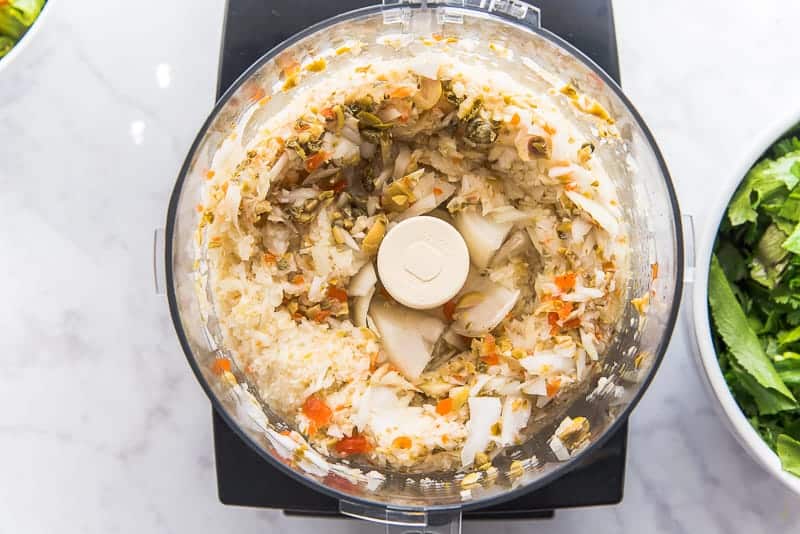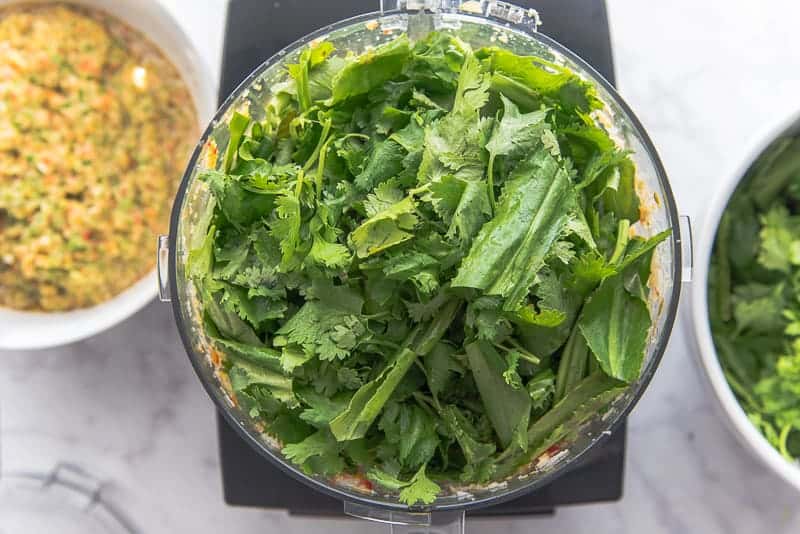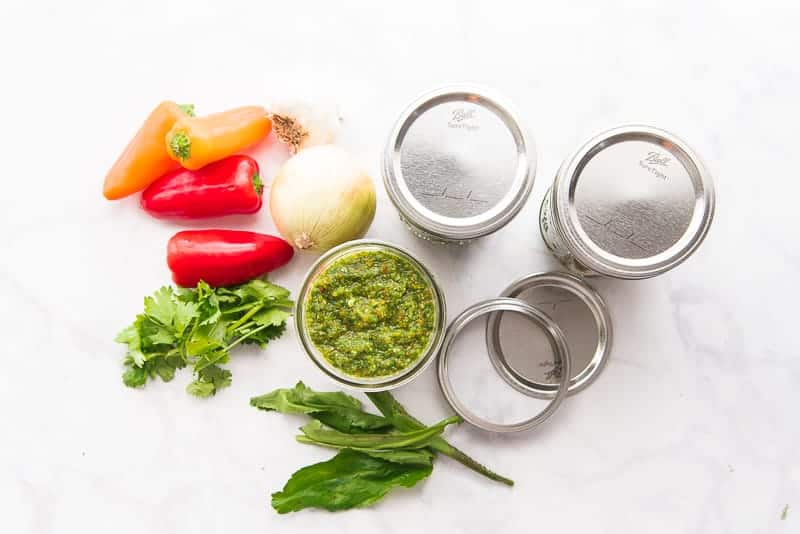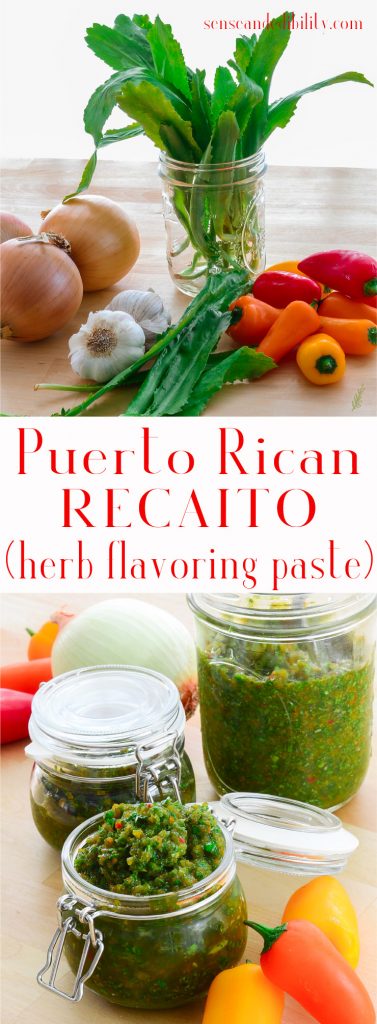My authentic Puerto Rican Sofrito recipe, pronounced soh-FREE-toe, is a culantro cooking base, adding uniquely bold flavors to your favorite Puerto Rican dishes and other Hispanic Caribbean recipes.
Every Puerto Rican family has a guarded sofrito recipe often passed down through generations. It’s so important to our cuisine that people are willing to risk a fine to sell it. I once knew a family in Brooklyn who got busted in a sting for operating an illegal sofrito business. Word on the street was that a rival was unhappy that they had the sofrito game locked down and ratted them out to “the man.” But, I ain’t no snitch, so you didn’t hear it from me.
Sofrito, recao, and recaito are often used interchangeably for the same recipe. The word sofrito is the process of cooking this flavor base with tomatoes, whereas recaito is just the green cooking base. Since the term sofrito is used by most Puerto Ricans to describe this recipe, I’ll refer to it as such.
Where Does Sofrito Come From?
This sofrito recipe is from Puerto Rico and is the flavor base of many dishes from the island. Many Caribbean islands have a version of sofrito called by different names. The Dominican Republic and Cuban sofrito are very similar to Puerto Rican recipes, with the main changes being the types of peppers used. Haitian epis and West Indian green sauce are different varieties of sofrito. All are amazing.
What Are The Ingredients In Sofrito?
The key ingredients in authentic sofrito are culantro, onions, garlic, and ajíes dulces (also called ajicitos dulces or sweet peppers), cilantro, olives and capers. Olives and capers add a bit of umami to my family recipe for sofrito. They are optional, but I really hope you try them.
Sofrito does not have tomatoes or tomato sauce unless you want to add it. Tomatoes not only water down the sofrito, but their use also binds you to that tomato-y flavor. This isn’t ideal if you plan to use it in recipes like pernil (roast pork), which doesn’t call for a tomato element.
Are Culantro and Cilantro The Same Herb?
Culantro (also known as recao, pronounced reh-CAHo) is not the same herb as cilantro. Culantro has a much stronger, savory flavor with broad, sawtooth leaves, while cilantro has smaller, frilly leaves and a slightly minty flavor. Because of culantro’s potent flavor, it’s used in small amounts to flavor recipes.
The word culantro is Latin for “foul-smelling thistle,” which makes sense because the culantro leaf has very tiny thorns. It also makes sense because one of culantro’s names is sawtooth coriander. I don’t think culantro has a foul smell at all. It smells like perfume to me.
You can find culantro in most Hispanic or Latin grocery stores. If you can’t find it there, try Asian markets near you. Many Asian stores carry it under the name Mexican coriander or ngò gai.
You can use cilantro instead of culantro if you can’t find it. It won’t be authentic sofrito, though, since culantro is the most important ingredient in sofrito. A replacement for culantro is 1 part Italian (or flat-leaf) parsley and 3 parts cilantro. We use cilantro in this recipe to add more depth of flavor to the recipe.
How Do I Prepare Culantro For Cooking?
You can use culantro in any recipe that calls for cilantro. In fact, if you’re unfortunate enough to have that aversion to cilantro, I suggest trying culantro in its place. Wherever a recipe calls for cilantro, use half of that amount in the bolder-flavored culantro.
Store fresh culantro leaves like you store cilantro: wrap the stems in a damp paper towel and place the leaves in a food storage bag. Keep the herb in the fridge and use it as needed.
To prepare culantro for making sofrito, rinse the leaves and shake them dry. Cut off and discard one inch from the stems of the culantro leaves and give the leaves a rough chop to prep them for the food processor.
Take a handful of cilantro and tear the leaves from the stems by twisting them with your other hand, and you’re done prepping it. Don’t add too much of the cilantro stems to the sofrito because it makes it taste bitter.
What Are Ajies Dulces?
Aji dulce is a sweet pepper used in Caribbean and Puerto Rican cooking. They taste like green peppers without the bitterness, and they don’t have the heat of habaneros. Don’t make the common mistake of purchasing and using habaneros or Scotch bonnet peppers instead of ajicitos dulces. Both will make your sofrito insufferably hot. Be sure to ask your grocer which peppers are which if they’re not labeled.
I add a combination of ajíes dulces and mini sweet peppers (also called sweet snacking peppers) because I like the sofrito to have some color. Mini sweet chili peppers (pictured on the left) are more widely available, so they are good substitutes for your ajíes dulces if you can’t find them. If you can’t find mini sweet peppers, use a variety of peppers, like orange, yellow, and red bell peppers and Cubanelle peppers, to make your sofrito. As a very last resort, you can use large green bell peppers. Since it’s a cooking pepper, it’ll make the cooking base taste bitter, so avoid them if you can.
Cut the tops off of the aji dulce peppers and discard the stems. Slice the peppers in half and remove the white rib from the inside. Next, shake or pluck out the seeds. Place the peppers in a bowl until you’re ready to start on the recipe.
Peel and rough chop the yellow onion and garlic cloves.
How Do I Finish The Sofrito?
The brininess of the olives and capers makes regular sofrito exceptional since they add another layer of umami to the recipe. Add the olives, capers, onions, and garlic to the bowl of a food processor or a blender.
Pulse the ingredients together 10 times. Don’t puree the mixture until smooth immediately, or the finished sofrito will be too soupy. Stop the food processor and use a rubber spatula to scrape down the sides of the bowl.
Add the chopped peppers to the bowl and pulse 8 or 9 times. The mixture will have the same consistency as salsa at this point.
This full recipe makes a large batch of sofrito, which is great because you will go through it quickly. For now, pour half of the mixture into a separate bowl to free up some room in the food processor. Add half of the culantro and cilantro to the remaining sofrito in the food processor bowl. Pulse this down before adding the rest of the leaves to the processor.
After the culantro and culantro are pulsed down, you will have enough room to add the rest of the mixture back to the food processor. Pulse 10 times until it is the consistency of pesto.
If you need a more in-depth video, check out this one on YouTube.
How Do I Store Sofrito?
The best way to store sofrito is in ice cube trays since an ice cube tray holds 1 tablespoon portions. A tablespoon or two is commonly called for when making Puerto Rican food, so freezing sofrito in trays makes for easy use when cooking.
Spoon the sofrito into an ice cube tray, cover it with plastic wrap, and freeze until solid. Transfer the cubes to an airtight container or freezer bag and use them as needed. I prefer this method of storing sofrito regardless of if I’m making it for later use because it’s more efficient. Frozen sofrito keeps for 6 months.
If you plan to use the sofrito within 14 days of making it, store it in a mason jar in the fridge. A jarful keeps well for about 2 weeks. The brine from the olives and capers helps retain its freshness. The longer sofrito is refrigerated sits in the fridge, the darker it becomes.
How Do I Use It?
Use this aromatic base in any recipes from Puerto Rican cuisine.
Add a tablespoon (or more) of sofrito to your favorite dishes. A couple of cubes of homemade sofrito is all you need to flavor a batch of arroz con gandules, bean dishes, rice dishes, or any of your favorite recipes, Puerto Rican or not. Heat your oil, drop in a couple of tablespoons of sofrito, and sauté until fragrant.
Sofrito eliminates the need to use onions and garlic- unless you’re like me and love the extra flavor. It’s a great way to boost the taste of any recipe you add it to.
This great recipe for Sofrito will be your secret ingredient after one use. You’ll soon see why it’s an essential ingredient in Puerto Rican cuisine and many other Latin American recipes. Pin this recipe for reference, and let your friends and family know you’re the new sofrito supplier in town!

Authentic Puerto Rican Sofrito
at Sense & EdibilityEquipment
- food processor or blender
Ingredients
- 1/2 cup olives pitted (optional)
- 1 tablespoon capers (optional)
- 3 large white onions peeled, rough chopped
- 3 heads (about 25 cloves) garlic peeled, rough chopped
- 1 pound aji dulce peppers stems and seeds removed
- 1/2 pound sweet peppers stems and seeds removed, rough chopped
- 6 bunches (about 1/2 pound) culantro leaves ends removed, rough chopped
- 3 bunches (about 1/3 pound) cilantro leaves only (triple if you're not able to find culantro)
Instructions
- In a food processor (or blender) add the olives, capers, onion, and garlic cloves.Pulse the ingredients together 10 times, or until coarsely chopped. Scrape down the bowl of the food processor with a rubber spatula.
- Add the peppers to the bowl and pulse 8-9 times. Scrape down the bowl once more.
- Pour out half of the pepper and onion mixture into a clean bowl. Add the culantro and cilantro leaves to the food processor and pulse until the leaves are broken down- this can be done in stages if necessary.
- Return the pepper and onion that you reserved back to the food processor and pulse until the sofrito is semi-smooth (the consistency of chunky applesauce).
- Transfer the sofrito into mason jars or into ice cube trays to freeze* for later use.

















I have honestly never heard of culantro so I doubt I’ll be able to find it locally but this sounds so delicious! I love the beautiful vibrant, fresh flavors and cannot wait to try it with cilantro!
Tammy, look for an Asian market. They usually have it fresh or frozen. The coolest thing is that the parsley/cilantro combination deliver the same flavor profile. Enjoy!
Haven’t tried this before. But I loved the recipe and the post. So will surely try soon. It’s amazing how we can use this in various recipes.
Aditi,
It is a very versatile recipe. Thanks for your kind words.
One of the few Puerto Rican chefs that I’ve come across that says ever family has their own recipe or way of making their personal sofrito. My recipe is similar except that I add the capers and olives when I get to the cooking. That makes my sofrito more versatile by allowing me to make Italian sauces by adding basil and or parsley, ginger and lemongrass and it becomes Asian. I am also from another generation born in the 1930’s so many things have changed. There was no Goya when I was born, they had just started and we didn’t see their products until the late 40’s early 50’s. My mother grew cilantro and culantro in a wooden cheese box on a window sill in the Bronx. In those days you had to go to Spanish Harlem to buy your Latino products because your local Americano stores didn’t sell any. Now I live in California and you can’t find culantro, but in Asian stores.Good thing we got Koreans, Chinese, Filipinos and Japanese markets. El aji dulce is still hard to find fresh, maybe frozen. I’m a new fan, love your page!
Aww, welcome!
Yes, in my years, I’ve noticed that every family makes it differently even if they’re small changes.
Oh my gosh, I want to eat this green gold by the spoonful!! I really enjoy the useful information you provide about ingredients and especially the substitution suggestions you make. I can’t find all these amazing-looking ingredients in my Northern hometown, but I have to say now I’m obsessed with culantro! I will ask around my farmer’s market in case anyone’s growing it and I just haven’t noticed it before.
Yes, and don’t forget to check out Asian markets for it, too!
Marta, I love your blog. I always learn something new and to me, that is the best part of cooking! I thought at first you had a typo with the culantro but hey, that’s a new ingredient to me. I have never seen it up here in Canada. Wonder if I could grow it?
Bernice, we had a few sprouts growing and the February winter storm killed it. You can buy the seeds online. Let me know if you’re successful.
I have never heard of culantro, but now I’m going to keep my eye out for some so I can make this delicious-looking recipe! Thanks for sharing!
When you visit your local Hispanic or Asian market, check out their refrigerated produce. That’s where they hide the good stuff. LOL!